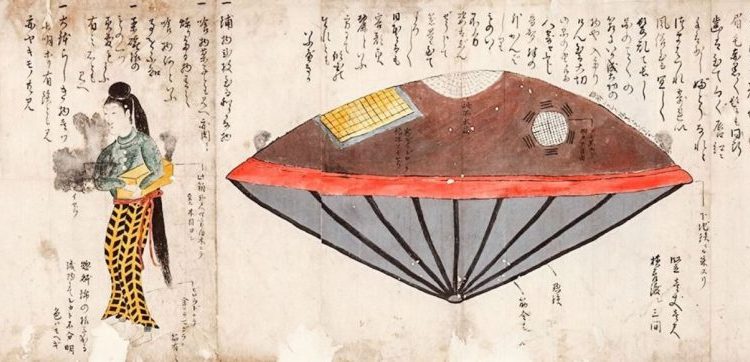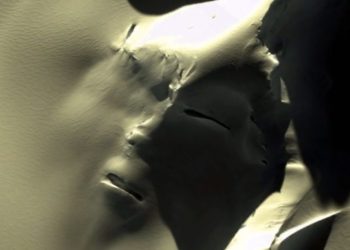Utsuro-Bune—which essentially means hollow ship—refers to a supposed “otherworldly encounter” of an unknown object that washed ashore the coast of Japan in the Hitachi province in 1803. The odd encounter is mentioned in three ancient texts, the Toen shōsetsu (1825), Hyōryū kishū (1835) and Ume-no-chiri (1844).
But what do the ancient texts describe? An ancient UFO washing ashore the coast of Japan, or mere folklore misinterpreted and adjusted in modern times to fit a description of a UFO?
There are plenty of alleged descriptions of UFOs in ancient times. Although some of them can probably be dismissed as weather phenomena or atmospheric events, there are certain descriptions that arouse our imagination. One of them is the Utsuro-Bune legend, which tells of a mysterious encounter of an “odd ship” that washed ashore on the coast of medieval Japan in 1803.
From the “hollow ship,” legends say that a young woman between the age of 18 and 20 emerged, dressed in a strange wardrobe.
The young woman was brought inland and offered shelter, but she was unable to communicate in Japanese and was very different from the people that had rescued her. Eventually, the fishermen returned her to her vessel, where it ultimately drifted away, disappearing in the horizon, never to be seen again.
The best sources for the mysterious encounter are the three ancient narratives, the Toen shōsetsu (1825), Hyōryū kishū (1835) and Ume-no-chiri (1844).
Then again, they don’t offer conclusive evidence of an otherworldly encounter as some suspect, and it is not possible for anyone to know whether the event that the texts describe was real or a product of local folklore.
The odd encounter has been investigated on several occasions, always resulting in more questions than answers, although we can agree on the fact that the vessel described in the Utsuro-Bune was not a technologically advanced one.
A mysterious encounter
The legend goes that in February 1803, local fishermen found a strange boat adrift. They managed to bring it ashore, and their descriptions say it was around 3.30 meters tall, 5.50 meters wide, and its shape reminded the Japanese fishermen of an incense burner.
Depending on which source you investigate, the vessel’s upper part appeared to be constructed of red stucco, while the lower part was covered with shiny bronze plates. The upper part of the vessel is described as having several windows made of glass or crystal.
The completely transparent windows gave the awestruck fishermen the ability to peek inside the vessel where they could see glimpses of a text written in an unknown language, as well as strange symbols, lines, and geometric figures.
Depending on which story you read, there were symbols both in the interior and exterior of the vessels. The symbols are described as something never before seen by the fishermen.
The woman said to have been around 1.5 meters in height had reddish hair and was dressed in clothes that the fishermen had never seen before. In her hand, she carried a small wooden box, no more than 30 centimeters in length. The contents of the box were not revealed to the fishermen, and the woman reportedly held onto the box tightly, not letting anyone near it. Whatever its contents, they must have been of great value.
An ancient UFO?

The legend of Utsuro-Bune has been used amply in modern times as a representation of visitations of UFOs in ancient times. The UFO idea is mostly based on the disc-shaped appearance of the vessel, and the fact it was covered in strange, unrecognizable symbols.
But does that really make it a UFO? In my opinion, not necessarily, although it may seem appealing to the subject.
An interesting explanation to the “odd” encounter is offered by Kunio Yanagita, a historian and ethnologist and the father of Japanese native folkloristics in 1925 and 1962.
In his work, the researcher explains that circular or disc-shaped vessels were never unusual in Japan from the earliest times; only the details such as the glass windows and bronze plates make the Utsuro-Bune look exotic.
The researcher also found that most legends similar to the Utsuro-Bune sound pretty much the same.
Yanagita notes that in all similar legends, someone finds a strange girl or young woman inside a disklike boat and rescues her, and then sends her back to the ocean.
The researcher also points out that the older versions of Utsuro-Bune describe a record of humble, circular, open ships without any dome on top.
Yanagida assumes that the details of the bronze plates and glass or glass windows have been added in order to add to the seaworthiness of a ship on high seas.
Further evidence as to why the Utsuro-Bune likely does not describe a technologically advanced vessel, or a UFO for that matter, is revealed by a Japanese professor of computer engineering and electronics at Gifu University in Tokyo called Kazuo Tanaka, who explains that the Utsuro-Bune is never described as flying or moving on its own.
No descriptions of the “hollow ship” explain it ever having had the ability to fly. In other words, in the descriptions, the vessel is not described as having motion on its own, nor does it show any signs of extraordinary technologies. It simply moves motionless in the water.
Oh and, let’s not forget that none of the descriptions of the young woman mention that she looked any different than what the people who “rescued” here looked like. Given her normal appearance, I’d highly doubt that the fishermen of the coast of Japan rescued a visitor from another planet.
Join the discussion and participate in awesome giveaways in our mobile Telegram group. Join Curiosmos on Telegram Today. t.me/Curiosmos











